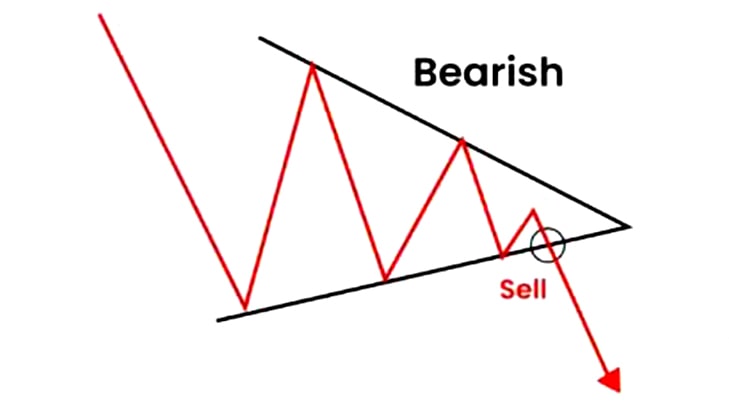
The bearish symmetrical triangle chart pattern is a technical analysis pattern that typically forms within financial markets, signaling a potential continuation of an existing downtrend. Here’s how it’s characterized:
Triangle Formation: Similar to the bullish symmetrical triangle pattern, the bearish symmetrical triangle consists of two converging trendlines. However, in this case, the pattern occurs within a downtrend. One trendline represents the upper resistance line, while the other represents the lower support line. These trendlines converge to form a symmetrical triangle pattern.
Lower Highs: The upper trendline connects a series of lower highs, indicating that sellers are stepping in to sell at lower prices.
Higher Lows: The lower trendline connects a series of higher lows, suggesting that buyers are willing to buy at progressively higher prices.
Convergence: As the price approaches the apex of the triangle, the distance between the support and resistance lines decreases, indicating a contraction in price volatility.
Volume: Volume tends to diminish as the pattern progresses, reflecting the uncertainty and indecision among market participants.
Breakdown: The pattern is considered complete when the price breaks down below the lower support line, typically accompanied by an increase in volume. This breakdown confirms the bearish bias and signals a potential continuation of the downtrend.
Trading the bearish symmetrical triangle pattern often involves entering a short (sell) position once the breakdown occurs, with a stop-loss order placed above the upper trendline to manage risk. Traders may also use other technical indicators or chart patterns to confirm the validity of the breakdown and to identify potential price targets.
As with any technical analysis pattern, it’s essential to consider other factors such as market conditions, fundamental analysis, and risk management principles before making trading decisions solely based on the bearish symmetrical triangle pattern.

मंदी सममित त्रिकोण चार्ट पैटर्न एक तकनीकी विश्लेषण पैटर्न है जो आम तौर पर वित्तीय बाजारों के भीतर बनता है, जो मौजूदा डाउनट्रेंड की संभावित निरंतरता का संकेत देता है। इसकी विशेषता इस प्रकार है:
- त्रिभुज निर्माण: तेजी सममित त्रिभुज पैटर्न के समान, मंदी सममित त्रिभुज में दो अभिसरण प्रवृत्ति रेखाएँ होती हैं। हालाँकि, इस मामले में, पैटर्न डाउनट्रेंड के भीतर होता है। एक ट्रेंडलाइन ऊपरी प्रतिरोध रेखा का प्रतिनिधित्व करती है, जबकि दूसरी निचली समर्थन रेखा का प्रतिनिधित्व करती है। ये ट्रेंडलाइन एक सममित त्रिकोण पैटर्न बनाने के लिए एकत्रित होती हैं।
- निचली ऊँचाई: ऊपरी ट्रेंडलाइन निचली ऊँचाइयों की एक श्रृंखला को जोड़ती है, जो दर्शाती है कि विक्रेता कम कीमतों पर बेचने के लिए कदम उठा रहे हैं।
- उच्चतर निम्न: निचली प्रवृत्ति रेखा उच्चतर निम्न की एक श्रृंखला को जोड़ती है, जिससे पता चलता है कि खरीदार उत्तरोत्तर उच्च कीमतों पर खरीदारी करने के इच्छुक हैं।
- अभिसरण: जैसे-जैसे कीमत त्रिकोण के शीर्ष पर पहुंचती है, समर्थन और प्रतिरोध रेखाओं के बीच की दूरी कम हो जाती है, जो मूल्य अस्थिरता में संकुचन का संकेत देती है।
- वॉल्यूम: जैसे-जैसे पैटर्न आगे बढ़ता है वॉल्यूम कम होता जाता है, जो बाजार सहभागियों के बीच अनिश्चितता और अनिर्णय को दर्शाता है।
- ब्रेकडाउन: पैटर्न को तब पूर्ण माना जाता है जब कीमत निचली समर्थन रेखा से नीचे गिर जाती है, आमतौर पर वॉल्यूम में वृद्धि के साथ। यह ब्रेकडाउन मंदी के पूर्वाग्रह की पुष्टि करता है और डाउनट्रेंड की संभावित निरंतरता का संकेत देता है।
मंदी के सममित त्रिकोण पैटर्न में व्यापार करने में अक्सर ब्रेकडाउन होने पर शॉर्ट (सेल) स्थिति में प्रवेश करना शामिल होता है, जिसमें जोखिम को प्रबंधित करने के लिए ऊपरी ट्रेंडलाइन के ऊपर स्टॉप-लॉस ऑर्डर रखा जाता है। ब्रेकडाउन की वैधता की पुष्टि करने और संभावित मूल्य लक्ष्य की पहचान करने के लिए व्यापारी अन्य तकनीकी संकेतक या चार्ट पैटर्न का भी उपयोग कर सकते हैं।
किसी भी तकनीकी विश्लेषण पैटर्न की तरह, केवल मंदी के सममित त्रिकोण पैटर्न के आधार पर व्यापारिक निर्णय लेने से पहले बाजार की स्थितियों, मौलिक विश्लेषण और जोखिम प्रबंधन सिद्धांतों जैसे अन्य कारकों पर विचार करना आवश्यक है।







